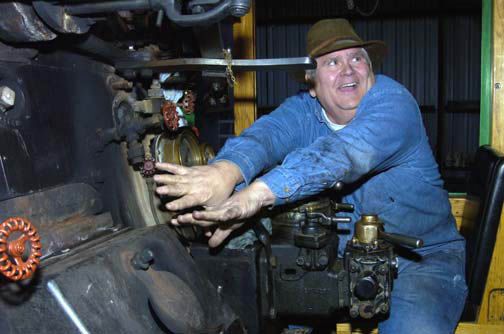Following dad’s (frozen) footsteps
Published 11:48 am Wednesday, October 21, 2009

- Jerry Latham lives in Scottsdale, Ariz., so even on a day considered balmy by Sumpter Valley standards, he relishes the warmth emanating from the boiler on a SVRR locomotive. (Baker City Herald/S. John Collins)
Jerry Latham traveled from Arizona to Sumpter to drive the same locomotive where his father was stuck in frigid Alaska 67 years ago
Jerry Latham warms his hands near the fire raging in the cab of this
steam locomotive – the very gesture his dad might have made nearly 67
years ago when stuck in the snow, in this same engine, at Fraser Pass
in Alaska.
“My dad was engineer on this engine,” he says.
Latham, 58, lives in Scottsdale, Ariz., and on Friday he arrived at the snow-free Sumpter Valley Railroad station at McEwen as the “Engineer for a Day.”
The program puts participants in the engineer’s seat for a full day of operating a narrow-gauge steam locomotive.
Latham’s engine was Mikado Number 19, which on Friday was also labeled as “81” – the number it was renamed when it went to Alaska.
Here’s a bit of history: 19 was built for the SVRR by the American Locomotive Works in 1920. In 1940 it was purchased by the White Pass and Yukon and was retired there in 1958. It returned to Oregon for complete restoration in 1977, and has been in regular service at Sumpter since 1996.
Latham’s father, Guy, enters the story in October 1942 when he was drafted into the 770th Railway Operating Detachment. He had one year of railroad experience.
“They were getting the new kids on the block who were railroaders and put them to work,” Latham says.
The military used the White Pass railroad during World War II to haul supplies and building material for the Alaska Highway, which was being completed from both the north and south ends to finish in the middle.
“The first winter they were there, they were in tents,” Latham says.
The trains ran every day, no matter the weather.
That was the case on Feb. 5, 1943. But the snow was too deep, and the train got stuck at Fraser Loop.
And there it stayed for seven days.
With a consistent temperature of 30 degrees below zero.
“When they ran out of coal, they started using railroad ties,” Latham says.
All the men survived, and on the fifth day the military parachuted in supplies.
“The first thing they went for was the cigarettes,” Latham says with a laugh.
His dad left Alaska in 1944 for combat training in Louisiana.
“They were going to be part of the landing force on mainland Japan,” he says.
En route, the company spent a week on a boat at Pearl Harbor. When news came in early August that the United States had dropped nuclear bombs on Hiroshima and Nagasaki, forcing the Japanese to surrender, the group headed to the Philippines to fix the railroad. Guy Latham rotated out from there.
After telling this story, Jerry Latham again rubs his hands together near the fire, which was taking its time heating water into steam to power the locomotive.
“I grew up on these stories,” he says. “I thought it was great as a kid – steam, fire.”
His dad never went back to the railroad, and instead became an elementary school teacher.
The stories stayed with Latham, though, and when his teacher asked what he wanted to be, he answered “an engineer.”
She then told him about all the math it takes to become an engineer.
“I didn’t have the heart to tell her I wanted to be a locomotive engineer,” he says.
Latham also went into education, and he retired from Scottsdale Community College two years ago.
“I never did get to do what I wanted to do. Until now,” he says.
On the search
Latham’s father died in 1985.
“The night before he passed away, he was talking about the White Pass,” he says. “He wanted me to have all the pictures from Alaska – he thought I could do something with them.”
In 1995, he took those photos on a trip to Alaska, and learned that No. 81 was being restored in Portland.
So he went to Portland.
“I knew it was destined for Sumpter Valley,” he says.
Then, several years ago, he joined a railroad fan group on the Internet, and posted an old photo of his dad leaning out the window of No. 81.
Taylor Rush, who is now the president of SVRR, responded and asked the identity of the man.
Latham planned to be an “Engineer for a Day” in 2007, but it didn’t work out.
This time it did.
“Finally I got to come up here and run my dad’s locomotive,” he says. “There’s something special about steam locomotives. They have a life of their own – they breathe.”


